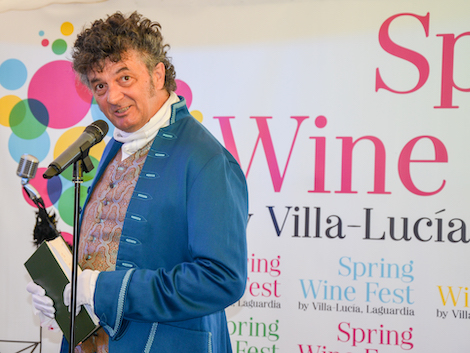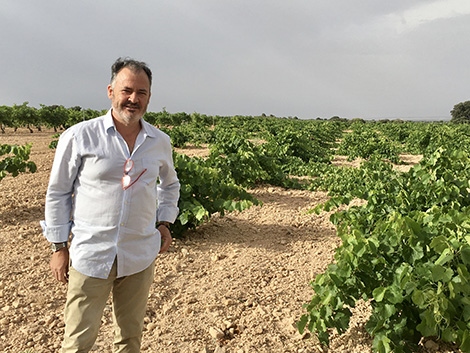
“The suitability of locations to plant vineyards is changing,” says winemaker Itziar Insausti of Doniene Gorrondona, amidst the beauty of Irimingorrieta, a vineyard bought in 2009 in partnership with her brother Egoitz, agricultural engineer Julen Frías and journalist Andoni Sarratea.
Perhaps not as well-known as other producers in the DO Bizkaiko Txakolina, an appellation near Bilbao covering over 420 hectares under vine, Doniene is a veteran name in the area crafting pure, distinctive txakolis and successfully experimenting with niche wines including sparkling, barrel-fermented and, more recently, natural wines.
Doniene Gorrondona is located in Bakio, a coastal village known for its surf beach and the picturesque islet of San Juan de Gaztelugatxe which was home to Dragonstone in the seventh season of the TV series Game of Thrones. It was established in the early 1990s after the partners bought a winery housed in the old Gorrondona caserío (the traditional Basque farmhouse), which was built in 1852.
As stated on the labels, most of the wines are made with grapes sourced from Bakio. The village managed to preserve its winemaking tradition during txakoli’s darkest hours. In the mid 1970s, one fifth of the 50 hectares under vine remaining in the province of Bizkaia were found here. Bakio was said to produce “dry, higher alcohol txakoli thanks to its climate, warmer than other inland areas,” according to the book El Viñedo Español published in 1975. Today, this gentle quality is still palpable on Doniene’s wines. Acidity is not necessarily lower, but it feels riper and is usually well-integrated in the wines.
New frontiers
Buying Irimingorrieta was a risky but firm decision in the midst of the financial downturn of the late 2000s in their attempt to avoid dependence on grape purveyors. Despite having planted some vineyards themselves in 1995, the four partners soon discovered the limited viability of renting old pergola-trained vines in the village. The plots were tiny and the partners found it difficult to maintain long-term relationships with their owners. They now work with only four grape suppliers, the most distant being in Artxanda, one of the mountains surrounding the city of Bilbao. All these grapes are destined to their entry-level wine called Gorrondona, which comes in the traditional Rhine-shaped bottle.
Irimingorrieta is a different story. Located on a fairly steep slope on a mountainous area, it covers eight and a half hectares with five of them under vine. At an elevation of 250 metres, "this is not a traditional site to grow vines," says Itziar. Unlike in Getaria, the vineyards in Bakio were planted with their backs to the sea or at some distance from it. Itziar describes the village as a basin with a significant amount of sediment in lower areas, and a limiting horizon of clay that increases vigour. "But as you move up," she explains, "the soils become more complex; schist and gypsum appear, and the roots can dig deeper."
Poor, highly acid soils on sandstone are dominant in Irimingorrieta. “It has taken considerable time and effort for plants to sink their roots here because they lived comfortably in the upper layers. We had to plough, then use yarrow and other herbs to strenghthen the plants and stop leaves from turning yellow in August,” Itziar says.
The effort seems worth it, based on the first results. "As the vineyard is well aerated, we are able to use less systemic products and test different farming practices. This year, downy mildew has caused a lot of damage on the less aerated plots". Yields in Irimingorrieta are absurdly low for the region: 3,000 kg/ha compared to Doniene's average, which ranges between 6,000 and 8,000 kg. "With yields of 9,000 kg upwards the style of the wines changes a great deal", warns Itziar. "The grapes do not ripen well and alcohol rarely exceeds 11% abv. In order to have structure both in musts and wines, yields must be limited".
Most of the Irimingorrieta grapes go to Doniene, the village txakoli aged under lees, yet the wine that best captures the character of Irimingorrieta is Iri. This is a 100% Hondarrabi Zuri aged under lees with no added sulphites and higher ripeness and concentration (13.5% abv in the 2019 vintage) with preserved citrus fruit and honeyed notes. Despite coming from a relatively young vineyard, the palate shows depth and bright acidity. Only 200 experimental bottles were produced in the 2017 vintage, but it was added to the range in 2018.
Hondarrabi zuri
Despite the trend towards increased cohabitation of Hondarrabi Zuri (Courbu Blanc) and Hondarrabi Zuri Zerratia (Petit Courbu) in the vineyards of DO Bizkaiko Txakolina, Doniene Gorrondona favours Hondarrabi Zuri for their whites. Both grape varieties are in the same ampelographic group, but Itziar finds that, in coastal areas, Hondarrabi Zuri outperforms Hondarrabi Zuri Zerratia. The Zerratia grape is prone to millerandage and seems to be particularly affected by sea winds during flowering, hence its surface is limited to less than a hectare in the Doniene vineyards.
“Folle Blanche used to be widely grown across Bizkaia, but in Bakio red grapes were dominant,” adds the Basque winemaker. Folle Blanche produces very low alcohol whites -around 8% abv.- in line with the txakolis of the past, but not with current trends. Thus it’s no surprise that it almost disappeared over the past three decades. The few remaining plants go to Doniene’s sparkling wine, where it accounts for around 20% of the blend and contributes to the citrus, vertical acidity of the wine.
The distinctive expression of coast-grown Hondarrabi Zuri emerges fully in Doniene, the lees-aged white sourced from some of their best plots in Bakio. It can age gracefully as I witnessed during a vertical tasting of vintages 2019, 2018, 2016 and 2014. Saline flavours emerge over time, as it’s the case with the 2014 vintage. Beyond the ripe, well-integrated acidity, I found herbal notes such as fennel, aniseed and bay leaves. Itziar says that using indigenous yeasts has resulted in an extended palette of herbal nuances. “We still have a lot to learn about fermenting with each of the vineyards’ yeasts,” she adds.
Grapes marked by the strong character of their soils (limestone, red gypsum) are destined to Ondarea. This white wine is fermented and aged in oak for three to four months, then spends a further year in bottle before release. The current 2017 vintage is broad, balanced and vibrant, still young and with good ageing potential. While the use of seasoned barrels keeps oak flavours under control, the Atlantic nature of the wine is obvious on its acidity. A keen explorer of the area’s potential and its grape varieties, Itziar acknowledges that she avoids crossing "the barrier where the wine doesn't feel like txakoli". The issue is that there isn’t a uniform perception of what is txakoli.
A benchmark red txakoli
The Bakio winery has also set the standard for red wines. Gorrondona, which was renamed Beltza (black, in Basque) in the 2018 vintage and has a 20-year track record, resumed the village tradition of making reds. Grapes were first sourced from old pergola-trained vineyards, but unfortunately most of them have been gradually uprooted. By the 2014 vintage, very few old vines remained in the blend. Today grapes are mainly sourced from a vineyard planted next to the winery (they used cuttings from the old vines) and from Irimingorrieta. Some Cabernet Franc plants are mixed among the Hondarrabi Beltza, which, in a way, proves the coexistence of these two varieties that are related and belong to the same family as Cabernet Sauvignon, Merlot or Carmenère. According to Wine Grapes, Cabernet Franc is the ancestor of all of them, but in the case of Hondarrabi Beltza the identity of the second progenitor is unknown.
I particularly enjoyed a second vertical of the red’s last four vintages. My favourite was 2016. I loved the Atlantic character of the wine, the silky tannins and the aromatic complexity developed over time with truffle and damp undergrowth aromas. There were also recurrent herbal and flint notes, particularly in 2017 and 2019. While 2018 felt ripe, 2019 was firm and promising.
Red txakoli occupies a tiny niche with barely eight hectares under vine out of 428 in the entire DO Bizkaiko Txakolina, but it should definitely occupy a place among the trend for Atlantic reds in Spain.
Itziar Insausti believes that in just a few years, txakoli has raced to complete the work that other areas have done in much longer time. Certainly, the variety of styles that have emerged in a short time can mislead consumers and make them doubt about the real identity of this wine. In this changing scenario, her priority is to maintain quality standards and keep both feet on the ground. Her goal: "I want to be able to create things that are different, but also replicable".

Amaya Cervera
A wine journalist with almost 30 years' experience, she is the founder of the award-winning Spanish Wine Lover website. In 2023, she won the National Gastronomy Award for Gastronomic Communication
NEWSLETTER
Join our community of Spanish wine lovers






